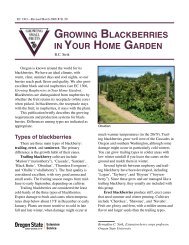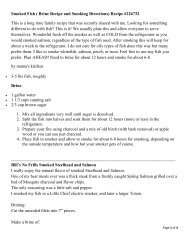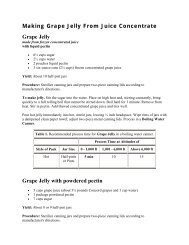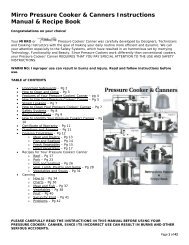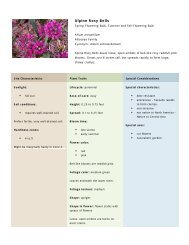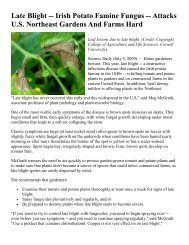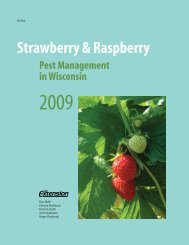Create successful ePaper yourself
Turn your PDF publications into a flip-book with our unique Google optimized e-Paper software.
WINTERIZING CONTAINERS-For items such as Patio Blueberry, Patio Strawberry,<br />
Patio Apple, Elephant Ears, Bougainvillea and Angel Trumpet, providing winter protection<br />
is very important, especially when outdoor temperatures drop below 29°F. Before freezing<br />
weather arrives, move your containers indoors to an unheated garage or cellar. Withhold<br />
fertilizer and water just enough to keep the soil slightly moist. In spring, when the danger of<br />
frost has passed, bring the containers outdoors once again and water thoroughly.<br />
-- - --<br />
FRUITS<br />
- -<br />
FRUIT & NUT TREES--Our 3-in-1 Apple tree is self-pollinating, so there's no need for<br />
another tree. Follow the six basic steps for planting bareroot trees, shrubs and hedges found<br />
on page 7. Proper planting depth is critical. The graft or bud union must be 1-2" above the soil<br />
surface and staking may be necessary to stabi lize the tree as it grows.<br />
Additionally, young fruit trees are subject to damage during winter months from foraging rabbits.<br />
Until year four, the lower 18-24" of the trunk requires a protective barrier during winter.<br />
For best results, plant nut trees in groups of two or more of like variety within 50 feet to<br />
increase their chances of pollination. Those not self-fruitful need a pollinator planted nearby.<br />
As your trees grow, prune in early spring, removing crossed or injured limbs and any branches<br />
which rub against each other. This allows light into the center of the tree. Don't cut short spurs<br />
from the main stem since these bear first fruit.<br />
The general rule is to prune less during the juvenile or early years, removing only the limbs that<br />
compete with desired limbs. Apple and pear varieties with a natural upright habit should have<br />
their limbs spread to a 60° angle.<br />
Starting in year five, prune out shaded or crowded limbs annually in late winter. Never leave<br />
stubs; cut limbs where they connect with the trunk or other limbs you want to keep.<br />
Regular spraying stops insects before they can damage your crop. Apply dormant oil before<br />
buds begin to swell in the spring. Spray trees with liquid fruit tree spray when flower petals fall.<br />
Make follow-up applications every 10 days or so until the harvest nears.<br />
BLACKBERRIES-All brambles require deep,<br />
well-drained loam soil high in organic matter. They<br />
can't tolerate sandy soil or soil that's so heavy it<br />
leaves moisture standing around the roots. Apply a<br />
balanced fertilizer at a rate of 10 pounds per 1,000<br />
square feet. Cut plants back to 6 inches and place<br />
them in the hole at the same depth they grew in the<br />
nursery row. Space blackberries 5-6 feet apart in<br />
rows 8-10 feet apart and provide a trellis for trailing<br />
types. Canes can be woven or tied to keep them in<br />
place. Do not allow canes to set fruit the first year.<br />
Water heavily and mulch to reduce weeds. Thick<br />
layers of shredded bark, leaves, wood chips and hay<br />
make excellent mulch for any type of berry.<br />
CURRANTS & GOOSEBERRIES-These plants<br />
do best in rich soil that is cool and moist but has good<br />
drainage. Plant 5 feet apart, in rows 8 feet apart, in full<br />
sun where summers are mild and in a partially shaded<br />
location where summers are hot and dry. Trim stems<br />
back by 213 after planting. Prune in spring after flowering.<br />
Fruit is produced on older wood-in the fall,<br />
remove any wood more than 3 years old.<br />
PAGE 10<br />
Training Blackberries<br />
Weave onto trellis




